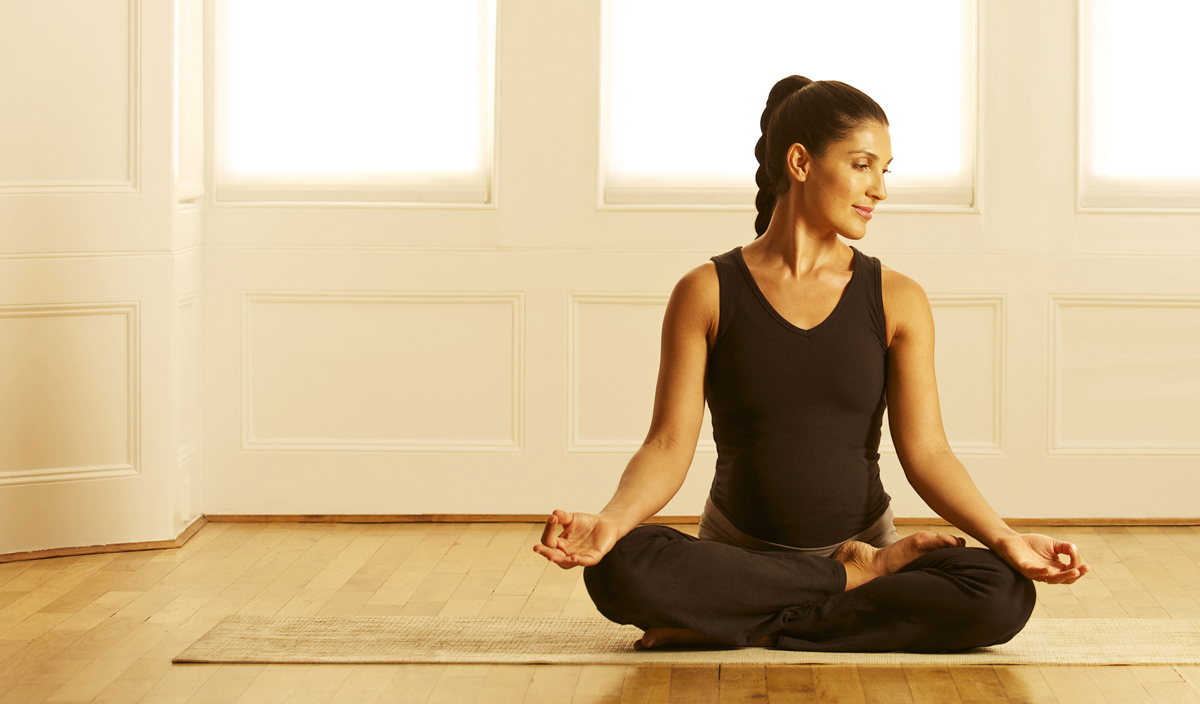

During pregnancy your emotions can swing from one extreme to another. The breath reflects your mental state, but it can also anchor and support you. Yoga increases awareness and control of breathing, so if you notice that your breath has become shallow because you are stressed, you can use it to bring yourself back into balance. The breath is something you can’t leave behind, even if you forget your hospital bag. And if labour starts before you’ve had time to pack, you will still have your main tool with you – so use it!
With each breath l send energy to my baby and the whole of my system.

I breathe deeply to create more space in my body for my baby.

My breath influences my state of mind.

I alone am responsible for how l breathe.

Breathing deeply, l let go of tension with each exhalation.
Breath is fundamental to life: the first thing we take when we enter this world and the last thing we take when we leave. Developing an easy, flowing breath is the cornerstone of any yoga practice, but during pregnancy it assumes a special significance. Breathing correctly is a wonderful tool that will empower and energize you – by tuning in to the rhythm of the taking in and the letting go of the breath, you can consciously nurture yourself and your baby.
Gently deepening and slowing the breath and keeping it moving calmly through your body will act as a needle, stitching movement to movement, enriching you and your baby’s life-support systems and connecting your physical being with your emotional and spiritual self. Breathing well, and feeling the mind and body responding, can remind us that we are responsible for the way in which we take care of ourselves, but also that we have to let go and trust nature to do the rest.
Learning the simple technique of allowing your breath to flow freely can assist both you and your baby on a number of levels throughout pregnancy as well as during labour and birth. Breathing in a calm, fluid, steady way helps you to move through life in a similar fashion, whereas restricted breath can lead to feelings of being stuck and unable to move forward. The state of your breathing has an impact on and is reflected in every area of life – from your level of confidence and the way you hold yourself to how you relate to others and manage everyday matters.
With yoga we can learn to breathe more deeply, naturally and without effort, and so encourage the vital capacity of the lungs. The quality of our inhalation affects our openness to receive love and joy, to feel fulfilled and to be as comfortable with receiving as with giving. The quality of our exhalation helps us to let go of emotional and physical tensions. We learn to use our breath to tune in to ourselves at a profound level and to find an infinite source of inner support that we can draw on throughout pregnancy and when giving birth.
Inhalation and exhalation can affect your physical, psychological, emotional and spiritual states, as well as your baby’s well-being. At its very basic level, breathing sustains the essential biological functions of you and your baby. With an awareness of your breathing you can also directly influence your state of mind and reduce stress throughout pregnancy and while giving birth. The breath can become a tool for you to draw on in any situation to regain a feeling of equilibrium and nurture yourself and your developing child.

In our frantic modern lives we are bombarded with external stimuli saturating the senses. Coming back to the simplicity of the breath helps to calm the mind and allows you to find your own natural rhythm. During pregnancy and birth your senses and emotions are naturally heightened, allowing you to tune in to the inner world of your mind and body more easily. This gift of awareness is also helpful during labour as you become fully attuned to your contractions and your breath in order to facilitate your baby’s birth. The shift in focus from the frantic concerns of the world to something that is so simple and basic is a relaxing meditation at your disposal whenever you need it.
Birth Story …
“We got to the birth centre just in time. I gave birth very soon afterwards in the birthing pool using gas and air, breathing, and the visualization techniques that I had practised in yoga. I won’t deny that there were difficult periods during the stronger contractions in the second stage of labour, but by using all of the above to try to keep relaxed and let the body do what it is meant to do, everything became surprisingly manageable. I also remembered to recite one of my favourite birth affirmations: ‘With every contraction my baby is coming closer to me.’ That really helped to put everything into perspective at the time.” Kate
Many of us take shallow breaths and rarely expand our lungs to their full capacity; we may even hold our breath when we encounter difficult situations. In this exercise you learn to slow down the breath and breathe deep into the abdomen, helping to reduce the secretion of stress hormones and soothe your baby. Inhaling massages your internal organs as well as your baby; exhaling expels toxins and waste from your system, revitalizing and renewing every cell, and providing energy.
1 Sitting with your legs crossed, rest your hands on your abdomen and close your eyes. Every time you breathe in feel your baby moving up toward your hands and notice whether your breath is shallow in your chest or deep in your abdomen. Deepen and lengthen your breath, and release your shoulders away from your ears. PAUSE  Breathing into the abdomen throughout the practice helps to send more oxygen to the baby and makes you feel more centred. Tune in to how you are feeling and notice any stuck or tight areas.
Breathing into the abdomen throughout the practice helps to send more oxygen to the baby and makes you feel more centred. Tune in to how you are feeling and notice any stuck or tight areas.
Slow down your breathing, direct your breath to those areas of discomfort and notice how your mind and breath can work together to release tension. Sit tall, anchoring down through the hips, lifting up through the spine to create space for your baby. Make sure you aren’t holding any tension in your face; keep your eyes soft by relaxing the muscles around your eyes.
2 Place your hands on your ribcage and as you inhale feel your ribcage expand laterally as your fingertips move farther away from each other.
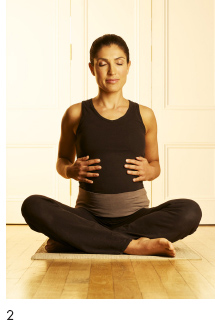
3 As you exhale, feel your fingers move back toward each other. PAUSE  Inhale, expand; exhale, soften. Listen to the sound of your breath as it moves in and out of your body and feel the movement of the breath creating space in your ribcage.
Inhale, expand; exhale, soften. Listen to the sound of your breath as it moves in and out of your body and feel the movement of the breath creating space in your ribcage.
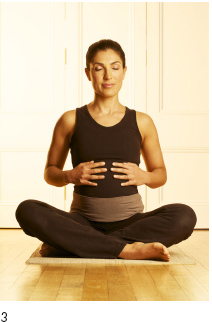
4 Now bring your fingertips up to rest just beneath your collar bones and breathe into this area, sending the breath into your chest. Make sure your shoulders stay down away from your ears. Send the breath all the way to the top of your lungs as you inhale, and imagine emptying them as you exhale. PAUSE  On the next inhalation imagine the breath moving into the back of your lungs.
On the next inhalation imagine the breath moving into the back of your lungs.
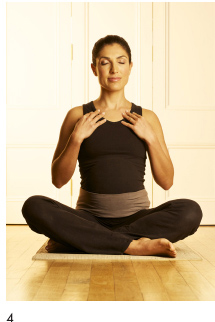
5 On your last exhalation bring your hands back down to rest on your baby and see whether your breathing feels a little deeper. PAUSE  Notice how you feel now. Do you feel more connected to your baby? Do you feel calmer? Is there a sense of stillness within? You may not feel any different, but just notice without judging yourself. Gently massage around your abdomen in a clockwise direction, imagining a golden circle of light around your baby. Now rest one hand on the heart centre and the other on your navel below the belly button and feel the breath moving in your body. PAUSE
Notice how you feel now. Do you feel more connected to your baby? Do you feel calmer? Is there a sense of stillness within? You may not feel any different, but just notice without judging yourself. Gently massage around your abdomen in a clockwise direction, imagining a golden circle of light around your baby. Now rest one hand on the heart centre and the other on your navel below the belly button and feel the breath moving in your body. PAUSE  With each breath imagine sending positive energy to your baby. Feel a connection from your heart to your baby’s heart, sending love to your baby.
With each breath imagine sending positive energy to your baby. Feel a connection from your heart to your baby’s heart, sending love to your baby.
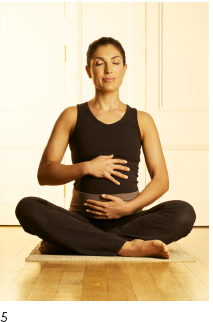
6 Now slowly open your eyes again, keeping your gaze soft and your face relaxed.
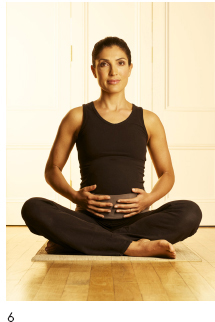
Alternate Nostril Breathing helps to balance masculine and feminine energy (see page 22) and calms, relaxes and refreshes all aspects of your mind and body. It can also help with insomnia. Avoid if you have severe nasal congestion.
1 Sit cross-legged. With eyes closed, take a deep breath in.
2 Close your right nostril with your right thumb, keeping your left nostril open. Inhale through the left nostril, then close it with the ring finger, release the thumb and exhale through the right nostril.

3 Inhale through the right nostril, then close it with the thumb, release the ring finger and exhale through the left nostril. Repeat Steps 2 and 3 for 1–2 minutes.

4 Keep the breath slow and relaxed, with in-breaths and out-breaths of similar length. Finish by exhaling through the left nostril to activate the feminine, lunar, calming and cooling energy.
5 Release your hand to your right knee and keep your eyes closed. Feel the breath moving more evenly through both nostrils now as you breathe deeply for a minute or longer. Slowly open your eyes when you feel ready.
The Alternate Nostril Breathing exercise on page 21 acts on the subtle body by opening up and purifying the channels of energy known in Sanskrit as nadis. It strengthens the nervous system and aligns the two sides of the brain by regulating masculine energy, associated with the right nostril, and feminine energy, associated with the left nostril. The exercise acts as a great emotional leveller, helping to correct the imbalances that can occur during pregnancy.
In contrast, Bellow Breathing provides relief from one of the physical changes associated with pregnancy. As the womb expands, especially in the later stages, the internal organs become compressed and many women feel rib pain and shortness of breath. One of the biggest benefits of practising yoga and yogic breathing (particularly Bellow Breathing) during pregnancy is that it helps to create more space in the abdomen to accommodate your growing baby.
1 Sitting tall, start by interlacing your fingers under your chin, keeping your elbows down.
2 Inhale through the nose, lifting your elbows high with palms down, and imagine filling your lungs with breath-like bellows.
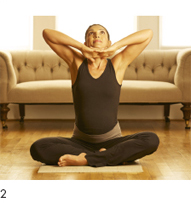
3 Exhale through the nose, lowering your elbows back down toward each other and emptying out your lungs.

4 Again inhale, elbows rising, breathing all the way up to your armpits, then release your elbows back down as you exhale slowly.
5 Now, as you inhale, see if you can find an extra 10 percent of room at the top of the breath and then exhale, letting go, emptying all the breath. PAUSE  On the in-breath notice the space you are creating in your body as your lungs fully expand, and the deep cleansing that comes with the exhalation. Repeat 3 more times.
On the in-breath notice the space you are creating in your body as your lungs fully expand, and the deep cleansing that comes with the exhalation. Repeat 3 more times.
6 This time as you inhale breathe in through your nose and as you exhale breathe out steadily through your mouth, blowing the breath away. Repeat gently 3 more times.
In this practice you will synchronize movement with the breath, adding sounds. When you add sound to the exhalation, it helps to lengthen the out-breath and gives the muscles more time to release, which will be helpful for labour and release mood-boosting endorphins. Sound also helps you to lose your inhibitions – this can improve your experience of labour. Your baby can hear and feel your voice from as early as 16 weeks in the womb. Visualizing sounds moving down your body to your baby bathes your baby in a pool of vibration and will help your energy to move downward, assisting the birth.
1 You can perform this exercise standing or seated. Start with your hands resting on your belly and notice how you are feeling. Breathing in deeply with palms turned upward by your sides, bring your palms to prayer pose in front of your heart and allow your arms to float up.
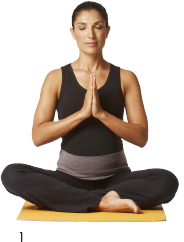
2 Let your palms meet above your head at the top of your inhalation.
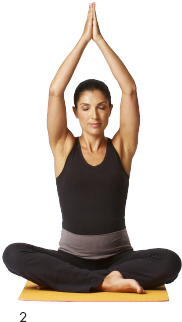
3 Slowly exhaling, float your arms back down (palms down) so your hands reach the floor by the end of the breath.
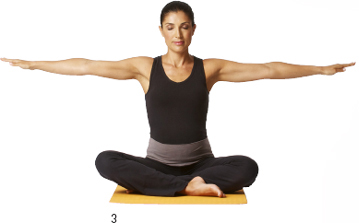
4 Inhale and let your arms float back up. Feel the space between your shoulders and your ears and allow your breath to guide the movement. Keep your breath fluid and don’t hold it at any time (your breath is an indicator of your state of mind). Release your arms back down.
5 Inhale, still breathing only through the nose, and lift your arms back up again. Now you will add sound to the movement – making a low “AAH” sound when releasing your arms back down. Notice how much longer the exhalation lasts when using sounds. Repeat this 3 times.
6 Now bring your arms down through the centre line, palms touching, making the sound “OM” (in three parts: “aaa” “oooo” “mmmm”). Your baby can hear and feel this vibration.
7 Place your hands back on your belly, close your eyes and reflect on how you feel now. Notice a sense of inner vibration that still remains.
8 Bring one hand up to your heart and place the other on your navel below your belly button. PAUSE  Feel the bond of love between you and your baby and give gratitude to life for this miracle growing within you.
Feel the bond of love between you and your baby and give gratitude to life for this miracle growing within you.
